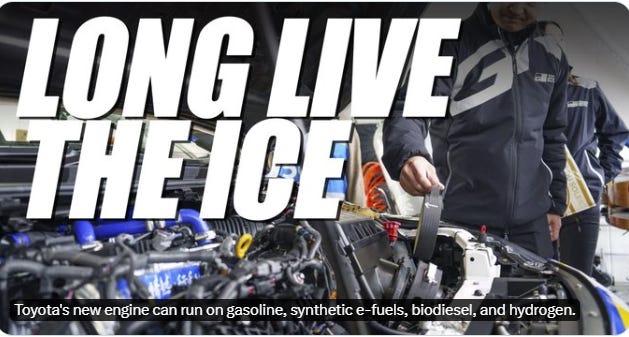We Have Seen the Automotive Future: Its Name is Toyota
Jun 8
Toyota set the climate alarm lobby on its ear again this weekwith introduction of a revolutionary new version of the demonized internalcombustion engine (ICE).
CarScoops reported Thursday that the new Toyota ICE is athermally efficient design that can run on gasoline, biodiesel, syntheticfuels, and hydrogen without loss of performance. If true, this is a step-changein automotive engineering that will enable the most innovative car company onearth to continue its current corporate strategy for decades.
Here’s an excerpt from the story at CarScoops:
Toyota has come under fire for being anti-EV and has even beenaccused of weakening nations’ climate policies through industry advocacygroups. Despite teasing the world with promises of a solid-state battery andintroducing its own EVs, the company remains committed to furthering existingtech, with a “multi-pathway approach” to reducing emissions.
Toyota’s goal of carbon neutrality involves not only batteryelectric vehicles but plug-in hybrids, conventional hybrids, and internal combustion engine cars. The company also remains committed to developing hydrogen technologies.
This furthering of hydrogen tech, it says, has resulted in thecreation of a new breed of thermally efficient engines that can run on avariety of fuels, including conventional gasoline, as well as carbon-neutraloptions such as synthetic e-fuels, biodiesel, and hydrogen.
Toyota’s chairman and former CEO, Akio Toyoda, pushed for thedevelopment of an H2-powered racing car. Rather than creating a fuel-cellvehicle like the pioneering Mirai, Toyota’s engineers sought a way to make the concept viable in a combustion engine. They settled on the 1.6-liter three-pot engine used in the GR Corolla. The car was later entered successfully in the Super Taikyu Series.
One of the challenges the company faced was balancing thermalefficiency, with hydrogen burning faster and hotter than gasoline. However,using lessons learned from the hydrogen-powered GR Corolla racing car, Toyota’sengineers have cracked how to make these engines even more efficient for thestreet.
[End]
There are many reasons why Toyota continues to be perhaps themost successful carmaker on earth even as public policies regulating theindustry continue to radically shift. This story is a clear example why.
- Forums
- Political Debate
- Hybrids Vs PHEVs vs All Electric
Hybrids Vs PHEVs vs All Electric, page-1096
Featured News
Featured News
The Watchlist
PAR
PARADIGM BIOPHARMACEUTICALS LIMITED..
Paul Rennie, MD & Founder
Paul Rennie
MD & Founder
SPONSORED BY The Market Online










